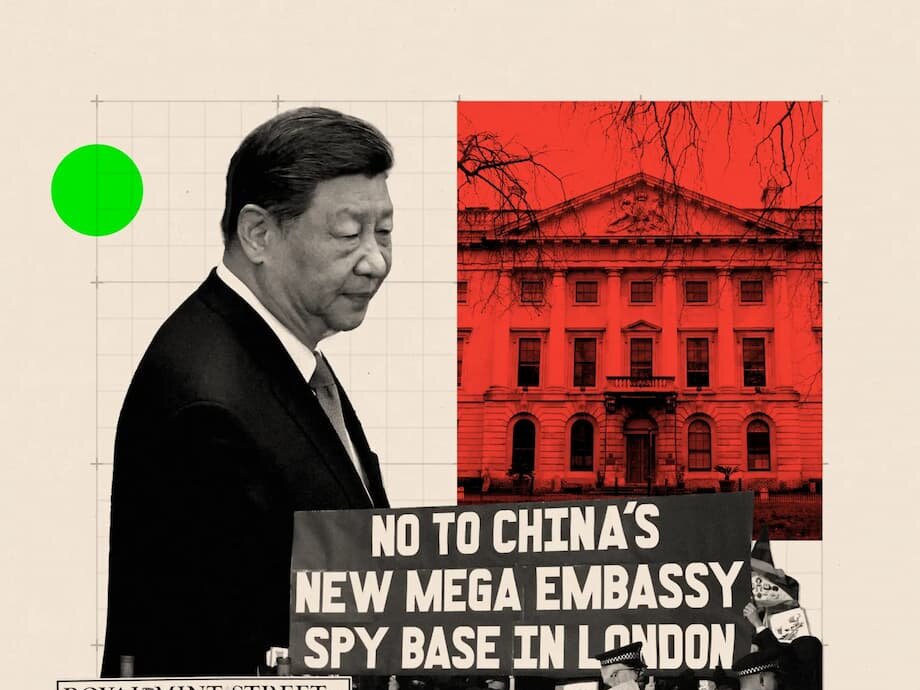China’s Mega-Embassy Plan in London: A New Diplomatic Era or Security Nightmare?
In the heart of London, just opposite the historic Tower of London, a fierce debate is raging over China’s proposal to build what would become the largest Chinese embassy in Europe. The plan to redevelop the former Royal Mint Court into a sprawling diplomatic compound has ignited concerns about national security, espionage, human rights, and the future of UK-China relations. As the UK government prepares to make a final decision, the controversy has drawn in local residents, rights activists, intelligence agencies, and even the White House, making this one of the most consequential diplomatic disputes in recent British history.
- China’s Mega-Embassy Plan in London: A New Diplomatic Era or Security Nightmare?
- What Is China Planning at Royal Mint Court?
- Security, Espionage, and the “Spy Hub” Allegations
- Protests, Public Outcry, and Local Opposition
- Political Maneuvering and the Decision Process
- Espionage, Cybersecurity, and the Future of UK-China Relations
- What Happens Next?
- In Summary
What Is China Planning at Royal Mint Court?
China’s vision for its new embassy is nothing short of monumental. The proposed complex would cover over 20,000 square meters (about 5.4 acres), dwarfing the current Chinese embassy in Marylebone, which has served since 1877. The site, purchased for £255 million in 2018, would include not only embassy offices but also 225 residential units for staff, a cultural center, conference and exhibition facilities, and a new visa application center. Architectural plans reveal extensive basement areas, suites of unlabeled rooms, and a tunnel connecting two buildings—features that have fueled suspicions about potential clandestine activities.
According to CSIS and Radio Free Asia, the embassy’s scale and design are unprecedented in Europe. The inclusion of secure underground spaces and a tunnel has raised red flags among security experts, who note that such features are difficult for host country security services to monitor and could be used for intelligence operations.
Why Is the Location So Sensitive?
The Royal Mint Court site is not just historically significant—it is strategically vital. It sits atop a web of fiber-optic cables and communication lines that serve London’s financial district, including the City and Canary Wharf. The site previously housed Barclays Bank’s trading floor and is adjacent to the Wapping Telephone Exchange, a major hub for data transmission. Security analysts warn that proximity to this infrastructure could, in theory, allow embassy staff to tap into sensitive communications, posing a risk to the UK’s financial system and international data flows.
Professor Periklis Petropoulos, an optoelectronics researcher at Southampton University, explained that “direct access to a working telephone exchange could allow people to glean information,” though he also noted that China’s broader cyber-espionage capabilities mean the risk is part of a wider strategic concern.
Security, Espionage, and the “Spy Hub” Allegations
At the core of the controversy are fears that the embassy could become a hub for Chinese espionage. Intelligence agencies, including MI5, have warned that the embassy’s location and scale could be exploited for spying on the UK’s financial sector, government, and even allied intelligence operations. The United States has expressed deep concern, with officials warning that the embassy could compromise intelligence sharing between the UK and its closest allies.
According to the London Evening Standard, the White House has urged Prime Minister Keir Starmer to block the project, citing the Chinese Communist Party’s “track record of targeting critical infrastructure.” American diplomats have even suggested that approval of the embassy could affect US-UK trade negotiations and intelligence cooperation.
Local politicians and campaigners have echoed these concerns. Conservative MP Sir Iain Duncan Smith described the plan as “kissing up to China,” while Shadow Home Secretary Chris Philp warned that the embassy could become a base for pan-European espionage activities. Human rights groups and exiled activists, including Hong Kongers, Tibetans, and Uighurs, fear the embassy could facilitate surveillance and intimidation of dissidents living in the UK.
China’s Response
The Chinese embassy has dismissed the allegations as “slander,” insisting that the project will promote friendship and mutual understanding between the Chinese and British peoples. In official statements, Chinese diplomats have accused “anti-China forces” of using security risks as an excuse to interfere with the planning process, calling such moves “despicable and unpopular.”
China has also linked approval of the London embassy to the stalled renovation of the UK’s embassy in Beijing, framing the issue as a matter of diplomatic reciprocity.
Protests, Public Outcry, and Local Opposition
The embassy plan has sparked a wave of protests and public meetings. Thousands of demonstrators—including exiled Hong Kong activists, human rights campaigners, and local residents—have rallied against the project. According to Firstpost and VOA, protests have drawn crowds of up to 6,000 people at the proposed site, with demonstrators voicing fears about surveillance, repression, and the loss of privacy.
Carmen Lau, a former Hong Kong district councillor who fled to London in 2021, has become a prominent voice in the opposition. She claims to have been targeted by Chinese state media and placed on a wanted list with a £95,000 reward for her capture. “The regime just tries to eliminate any possible activists overseas,” she said, recalling how friends and colleagues were arrested in Hong Kong and how she continues to feel threatened in the UK.
Local residents, such as Mark Nygate, worry about the impact on their daily lives. “Embassy staff will live there and overlook us,” he said. “We don’t want [the embassy] there because of demonstrations, because of the security risks, because of our privacy.”
Heritage and Urban Impact
Beyond security, the project has raised concerns about the preservation of London’s heritage. The Royal Mint Court site is steeped in history, with roots dating back to the 14th century and a legacy as the home of Britain’s coinage for nearly 200 years. Critics argue that the scale and design of the embassy could damage the character of the area and disrupt tourism, especially given its proximity to major landmarks.
Political Maneuvering and the Decision Process
The embassy proposal has become a political flashpoint, exposing divisions within the UK government and between local and national authorities. Tower Hamlets Council, which governs the area, unanimously rejected the plan in 2022 and again in 2024, citing security and public order risks. The Metropolitan Police initially objected, warning that the embassy could attract large protests and strain police resources, but later withdrew their objections after the central government took over the decision.
After Labour’s election victory in July 2024, the decision was “called in” by Deputy Prime Minister Angela Rayner, removing it from local control. This move followed lobbying by Foreign Secretary David Lammy and came after Prime Minister Keir Starmer discussed the embassy with Chinese President Xi Jinping. The timing has fueled speculation that the government may approve the project to preserve diplomatic and economic ties with China.
Professor Tony Travers of the London School of Economics noted that “politics is involved in planning decisions,” even if the process is supposed to be evidence-based. Lord Peter Ricketts, a former national security adviser, described the embassy debate as emblematic of the UK’s “acute dilemmas” in balancing long-term relations with China against short-term security threats.
International Pressure and Geopolitical Stakes
The embassy dispute has reverberated far beyond London. The United States, the Netherlands, and other allies have raised concerns about the security implications, with some warning that approval could affect intelligence sharing and trade negotiations. According to AInvest, the controversy has become a flashpoint in global geopolitics, intertwining national security, trade, and cybersecurity. The US has reportedly linked approval of the embassy to broader issues, including tariffs on UK steel exports and the resilience of critical infrastructure.
For the UK, the embassy decision is a test of its ability to balance economic interests with security imperatives and alliance commitments. The Labour government, eager to boost economic growth and improve ties with China, faces pressure from both domestic critics and international partners to prioritize national security.
Espionage, Cybersecurity, and the Future of UK-China Relations
The embassy controversy comes amid a broader reassessment of the UK’s relationship with China. In recent years, allegations of Chinese espionage, cyberattacks, and transnational repression have strained ties. The UK government has published national security strategies highlighting the dual challenge of engaging with China as a major economic partner while countering its attempts to “steal intellectual property or suborn citizens.”
Security experts warn that the embassy could serve as a base for both traditional and cyber-espionage. The proximity to data centers and communication cables raises the risk of physical tapping, while China’s advanced cyber capabilities mean that digital surveillance is also a concern. The issue has prompted calls for new laws and stricter cybersecurity measures, both in the UK and across the European Union.
Yet some analysts, such as Professor Steve Tsang of the SOAS China Institute, argue that consolidating Chinese diplomatic staff in one location could make their activities easier to monitor. “Allowing the Chinese to put their staff on one site is preferable,” he said, “because they’re at the moment all over the place in London, you can’t actually keep an eye on them.”
Diplomatic Reciprocity and Economic Stakes
China has framed the embassy project as a matter of diplomatic reciprocity, linking it to the UK’s stalled embassy renovations in Beijing. Economic considerations also loom large: China is a key trading partner, and the UK faces a significant trade deficit with the country. Some government officials argue that approving the embassy could help attract Chinese investment and improve bilateral relations.
However, critics warn that economic benefits should not come at the expense of national security. As Luke de Pulford, executive director of the Inter-Parliamentary Alliance on China, put it: “The UK and US should not compromise national security for trade, and the embassy should not be allowed.”
What Happens Next?
The final decision on the embassy now rests with Communities Secretary Angela Rayner, who is expected to announce her verdict following a public inquiry. The government has committed to a “robust, evidence-based” process, but the outcome will inevitably be shaped by political, economic, and security considerations.
Whatever the decision, the embassy dispute has already reshaped the debate over UK-China relations, highlighting the challenges of balancing openness with vigilance in an era of rising geopolitical tension. For local residents, activists, and policymakers alike, the fate of Royal Mint Court has become a symbol of the broader struggle to define Britain’s place in a rapidly changing world.
In Summary
- China’s plan to build a mega-embassy at Royal Mint Court in London has sparked fierce debate over security, espionage, and human rights.
- The proposed embassy would be the largest in Europe, with extensive underground facilities and proximity to sensitive communication infrastructure.
- Security agencies, local residents, and human rights groups fear the embassy could facilitate surveillance, repression, and cyber-espionage.
- The United States and other allies have warned that approval could affect intelligence sharing and trade negotiations.
- China insists the project is about friendship and reciprocity, linking it to UK embassy renovations in Beijing.
- The UK government faces a difficult decision, balancing economic interests with national security and alliance commitments.
- The outcome will have lasting implications for UK-China relations and the security of London’s financial and digital infrastructure.












